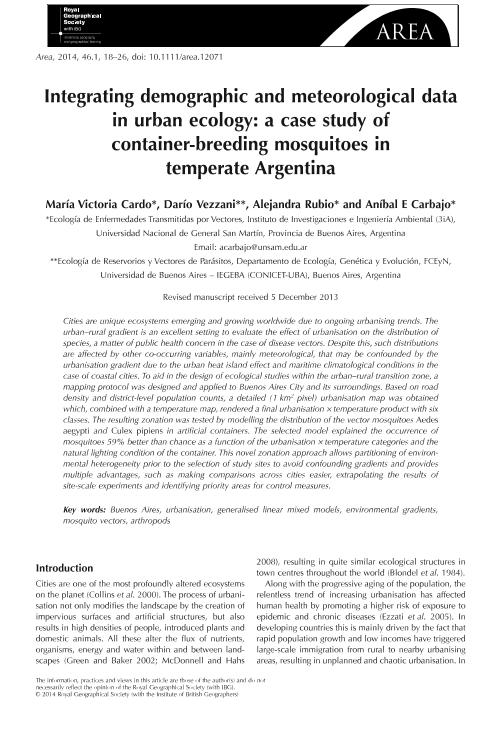Mostrar el registro sencillo del ítem
dc.contributor.author
Cardo, María Victoria

dc.contributor.author
Vezzani, Dario

dc.contributor.author
Rubio, Alejandra

dc.contributor.author
Carbajo, Anibal Eduardo

dc.date.available
2017-12-28T15:43:12Z
dc.date.issued
2014-02
dc.identifier.citation
Carbajo, Anibal Eduardo; Rubio, Alejandra; Vezzani, Dario; Cardo, María Victoria; Integrating demographic and meteorological data in urban ecology: a case study of container-breeding mosquitoes in temperate Argentina; Wiley; Area; 46; 1; 2-2014; 18-26
dc.identifier.issn
1475-4762
dc.identifier.uri
http://hdl.handle.net/11336/31797
dc.description.abstract
Cities are unique ecosystems emerging and growing worldwide due to ongoing urbanising trends. The urban–rural gradient is an excellent setting to evaluate the effect of urbanisation on the distribution of species, a matter of public health concern in the case of disease vectors. Despite this, such distributions are affected by other co-occurring variables, mainly meteorological, that may be confounded by the urbanisation gradient due to the urban heat island effect and maritime climatological conditions in the case of coastal cities. To aid in the design of ecological studies within the urban–rural transition zone, a mapping protocol was designed and applied to Buenos Aires City and its surroundings. Based on road density and district-level population counts, a detailed (1 km2 pixel) urbanisation map was obtained which, combined with a temperature map, rendered a final urbanisation × temperature product with six classes. The resulting zonation was tested by modelling the distribution of the vector mosquitoes Aedes aegypti and Culex pipiens in artificial containers. The selected model explained the occurrence of mosquitoes 59% better than chance as a function of the urbanisation × temperature categories and the natural lighting condition of the container. This novel zonation approach allows partitioning of environmental heterogeneity prior to the selection of study sites to avoid confounding gradients and provides multiple advantages, such as making comparisons across cities easier, extrapolating the results of site-scale experiments and identifying priority areas for control measures.
dc.format
application/pdf
dc.language.iso
eng
dc.publisher
Wiley
dc.rights
info:eu-repo/semantics/openAccess
dc.rights.uri
https://creativecommons.org/licenses/by-nc-sa/2.5/ar/
dc.subject
Buenos Aires
dc.subject
Urbanization
dc.subject
Generalized Linear Mixed Models
dc.subject
Environmental Gradients
dc.subject
Mosquito Vectors
dc.subject
Arthropods
dc.subject.classification
Otras Ciencias Biológicas

dc.subject.classification
Ciencias Biológicas

dc.subject.classification
CIENCIAS NATURALES Y EXACTAS

dc.title
Integrating demographic and meteorological data in urban ecology: a case study of container-breeding mosquitoes in temperate Argentina
dc.type
info:eu-repo/semantics/article
dc.type
info:ar-repo/semantics/artículo
dc.type
info:eu-repo/semantics/publishedVersion
dc.date.updated
2017-12-12T18:52:56Z
dc.journal.volume
46
dc.journal.number
1
dc.journal.pagination
18-26
dc.journal.pais
Estados Unidos

dc.journal.ciudad
Hoboken
dc.description.fil
Fil: Cardo, María Victoria. Universidad Nacional de San Martín. Instituto de Investigaciones e Ingeniería Ambiental. Laboratorio de Ecología de Enfermedades Transmitidas por Vectores; Argentina. Consejo Nacional de Investigaciones Científicas y Técnicas; Argentina
dc.description.fil
Fil: Vezzani, Dario. Consejo Nacional de Investigaciones Científicas y Técnicas. Oficina de Coordinación Administrativa Ciudad Universitaria. Instituto de Ecología, Genética y Evolución de Buenos Aires. Universidad de Buenos Aires. Facultad de Ciencias Exactas y Naturales. Instituto de Ecología, Genética y Evolución de Buenos Aires; Argentina. Universidad de Buenos Aires. Facultad de Ciencias Exactas y Naturales. Departamento de Ecología, Genética y Evolución. Unidad de Ecología de Reservorios y Vectores de Parásitos; Argentina
dc.description.fil
Fil: Rubio, Alejandra. Consejo Nacional de Investigaciones Científicas y Técnicas; Argentina. Universidad Nacional de San Martín. Instituto de Investigaciones e Ingeniería Ambiental. Laboratorio de Ecología de Enfermedades Transmitidas por Vectores; Argentina
dc.description.fil
Fil: Carbajo, Anibal Eduardo. Consejo Nacional de Investigaciones Científicas y Técnicas; Argentina. Universidad Nacional de San Martín. Instituto de Investigaciones e Ingeniería Ambiental. Laboratorio de Ecología de Enfermedades Transmitidas por Vectores; Argentina
dc.journal.title
Area
dc.relation.alternativeid
info:eu-repo/semantics/altIdentifier/url/http://onlinelibrary.wiley.com/doi/10.1111/area.12071/abstract
dc.relation.alternativeid
info:eu-repo/semantics/altIdentifier/doi/http://dx.doi.org/10.1111/area.12071
Archivos asociados
